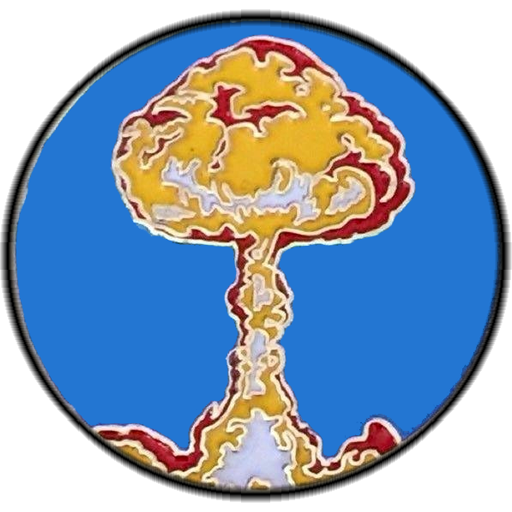Nuclear Explosive Package
Throughout the site, I will be referring to secondary thermonuclear stages as “supplementary” stages while still referring to the fission trigger as the “primary”.
| PRIMARY | SUPPLEMENT |
| Boa3.1 Cobra4.2 Gnat11.1 Komodo8.1 Python4.2 Robin3.1 Swan2.2 Tsetse Kinglet11.2 Starling11.2 | Flute Fife4.1 Piccolo4.3 Tuba Cursa Bassoon4.2 Whistle11.3 |
Prior to December 1956, the introduction of the first sealed-pit weapon the Mk25, all nuclear weapons excluding the Mk2 “Little Boy” and Mk3 “Fat Man” weapons used the capsule ball assembly. This assembly would contain the nuclear material that was inserted into the weapon “Pit” and was used not only as a safing system to prevent inadvertent detonation in the event of an aircraft accident during landing and takeoff, the physical separation of the fissionable material (capsule ball assembly, aka “core”) from the high explosive assembly acted as a firm delineation of custody between the Atomic Energy Commission (AEC) and the Department of Defense (DoD).
All weapon pits that use plutonium, contain at least 500 grams6.1
Optimal efficiency suggest that the secondary should contain equal numbers of atoms of the three ingredients; Lithium 6 (tritium), Lithium Deuteride (Deuterium), and Uranium. A secondary so composed would be about half uranium by volume, but 96 percent uranium by mass, with an average density of 10 kilograms per liter. Calculating from the well-known nuclear energy potential of the three ingredients, a one-liter secondary would yield 100 kilotons, assuming 50 percent efficiency of uranium fission. The secondary for a one-megaton warhead would thus be 10 liters in volume smaller if the fission efficiency were higher. A 10-liter sphere would be only eleven inches in diameter, easily small enough to fit inside the 20-inch diameter cylindrical casing of the Polaris A1 (UGM-27A) missile warhead, the Mk47, which was tested in 1958 and deployed in the 1960s. Dan Stober, of the San Jose Mercury News, says a version of this warhead contained the first spherical secondary, an arrangement which was soon to become the standard design. The advantage of a spherical secondary is higher compression. For example, if the walls of an 11-inch diameter cylinder are imploded inward four inches, the result is a three-inch diameter cylinder compressed by a factor of 15. On the other hand, if an 11-inch diameter sphere is imploded inward by the same four inches, the result is a three-inch diameter sphere compressed by a factor of 50.5.1
Tsetse
- Used in the Mk43
- Used in the Mk44
- Used in the Mk50
- Used in the Mk57
- Used in the Mk59
- Tested in Operation Hardtack I, shot Cactus1.2
Robin is a University of California Radiation Laboratory (UCRL), two-point initiated, primary.11.2
- Used in the Mk38
- Used in the Mk45
- Used in the Mk47
- Successors of the Robin were the Kinglet and the Starling11.2
- The two-point primary was a logical outgrowth of Livermore’s well-established linear implosion systems. It was developed during the course of many high-explosives (HE) tests at UCRL’s Site 300 firing range. The two-point primary was a breakthrough in explosives engineering, instead of compressing its contained fissile material via a focused shock wave the HE in the Robin employed a form of ablative burning, a near-instantaneous, highly-energetic deflagration which compressed the fissile material via reactive forces generated by the ablating explosive.
- The Robin developed in part out of computer modeling Livermore had completed for its linear implosion program for small-diameter U.S. Army artillery shells. Livermore devised computer models to calculate the physics and physical phenomena of a nuclear explosion. The geometry of these complex phenomena can be simplified into 1, 2, or 3-dimensional programs.
Whistle is a UCRL high-yield supplementary stage11.3
- Being designed in 195611.3
Piccolo is a UCRL supplemental stage
- Used in the Mk47
- Tested in Operation Hardtack I, shots Nutmeg, Aspen, Redwood, and Dogwood.
- May be a successor of either the Flute or Whistle stages.
Gnat is a Los Alamos Scientific Laboratory primary11.1
- Used in the EGG device, tested in Operation Redwing, shot Huron paired with a spherical supplemental stage within a ellipsoidal radiation case.11.1
Python is a 20″ in diameter Los Alamos Scientific Laboratory primary7.1
- Used in the Mk28
- Used in the Mk40
- Used in the Mk49
- Potentially tested in Operation Redwing
Swan is a Lawrence Radiation Laboratory (LRL), beryllium reflected, linear implosion primary.2.1
- tested in Operation Redwing shot Inca8.1 & shot Mohawk. In shot Mohawk, the Swan primary was paired with the Flute supplimentary1.1
- Measured 11.6″ in diameter, 22.8″ long and weighed 105lbs2.2
Cobra is a Los Alamos Scientific Laboratory (LASL) primary4.2
- Used in the Mk17
- Used the Type 150 capsule
Bassoon is a University of California Radiation Laboratory (UCRL) supplemental stage4.2
- Tested in Operation Redwing, Shot Zuni4.2
Cursa supplemental stage had a reported diameter of 172mm (7-inches), the implied efficiency of uranium fission would be more than 90 percent5.1
- Used in the Mk88
Kinglet
- Used in the Mk5812.1
Tuba is a Lawrence Livermore supplemental stage9.1
- Described as a spherical shape9.1
- Used in the Mk58
Komodo8.1
- Used in the Mk888.1
- Described as a “football-shape”8.1
- 172mm in diameter10.1
- Named after the Indonesian lizard, the Komodo dragon
Boa – Los Alamos designed primary3.1
- Used in the Mk30 and Mk523.1
Super Octopus
- Tested in Operation Storax, Shot Tendrac4.4 and Operation Nougat, Shot Pampas4.5
